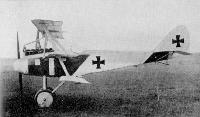
Описание
Страна: Германия
Год: 1916
Fighter
O.Thetford, P.Gray German Aircraft of the First World War (Putnam)
Euler Dr 1
The first Euler triplane, powered with 160 h.p. Oberursel U III. No data. The designation was not official, neither is it completely certain.
Euler Dr 2
Another experimental triplane powered with 160 h.p. Mercedes D III engine. No data. The designation was not official.
Euler Dr 3
Further experimental triplane, a development of Dr 2 fitted with 100 h.p. Oberursel U I engine. No data. The designation was not official.
Euler Dr 4
This triplane emerged from the Euler-Werke in 1916 and was an extremely ungainly aircraft intended for training duties and featuring side-by-side seating arrangement. Engine, 220 h.p. Mercedes D IV with reduction gears. Span, 10.0 m. (32 ft. 9 3/4 in.). Length, 8.0 m. (26 ft. 3 in.). Height, 3.1 m. (10 ft. 2 in.). Area, 37.5 sq.m. (405 sq.ft.). The designation was not official.
Описание:
- O.Thetford, P.Gray German Aircraft of the First World War (Putnam)
- W.Green, G.Swanborough The Complete Book of Fighters
Фотографии
-
M.Dusing - German & Austro-Hungarian Aero Engines of WWI. Vol.3 /Centennial Perspective/ (66)
Eul D.R.4 prototype (1915)
The first Euler single-seat fighter triplane was designed by Julius Hromadnik and was under test in the summer of 1917.
The only prototype Euler Dr 4 was powered by a 160 hp Oberursel U.III. It was designed as a testbed to compare biplanes and triplanes. -
W.Green, G.Swanborough - The Complete Book of Fighters
The private-venture Type 3 triplane was the second Euler-Werke fighter of this configuration.
-
O.Thetford, P.Gray - German Aircraft of the First World War /Putnam/
The only prototype Euler Dr 3 (Euler Dr 2 ???) was powered by a 160 hp Mercedes D.III.
-
W.Green, G.Swanborough - The Complete Book of Fighters
The most successful of the Euler-Hromadnik triplanes was the extremely neat Type 4 illustrated here.
The only prototype Euler Dr 7 was powered by a 110 hp Gobel Goe.II rotary. -
H.Cowin - Aviation Pioneers /Osprey/
Three other triplane fighter essays of 1917 were the rotary-powered Euler Dr 3, (photo) the 185hp Austro-Daimler powered Hansa-Brandenburg L 16 and the Korting engined DFW Dr I.
-
M.Dusing - German & Austro-Hungarian Aero Engines of WWI. Vol.2 /Centennial Perspective/ (65)
Euler D.R.7 triplane fighter prototype fitted with a Goebel Goe II engine.
-
J.Herris - Weird Wings of WWI /Centennial Perspective/ (70)
The final Euler fighting triplane (Type 5) is seen here in its original form
The only prototype Euler Dr 9 was powered by a 110 hp Siemens Sh.I. -
M.Dusing - German Aviation Industry in WWI. Volume 1 /Centennial Perspective/ (84)
Eul D.R. 9 triplane fighter prototype. (1917/18)
-
W.Green, G.Swanborough - The Complete Book of Fighters
The final Euler fighting triplane (Type 5) after the application of increased gap and deeper cabane.
-
K.Delve - World War One in the Air /Crowood/
Intended for training use, the Euler Dr4 was put forward in 1916 and was one of the only types to have side-by-side seating for the crew.
-
J.Herris - Weird Wings of WWI /Centennial Perspective/ (70)
The only prototype Euler Triplane (Euler Dr 4) was built in December 1916 and was powered by a 220 hp Mercedes D.IV. The aircraft was unarmed and the two crewmembers were seated side by side, indicating it was perhaps intended as a trainer.
-
W.Green, G.Swanborough - The Complete Book of Fighters
The Euler-Werke triplane fighter (Type 3).













